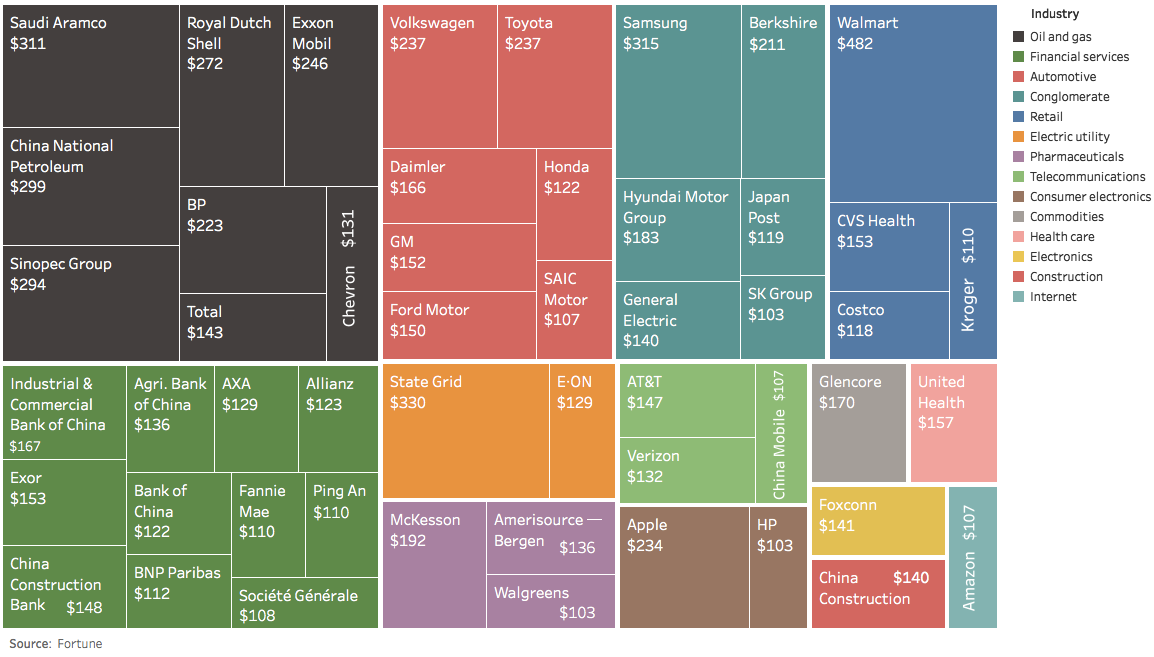Flying Under the Radar
While familiar global oil firms and massive banks make up a good portion of the companies on the list, there are also many companies in China and Europe that are less likely to ring a bell. Here is a primer on some of the companies that clearly rank among the world’s largest, but fly a little under the radar – especially for North Americans: Exor Have you heard of Exor? It was the second-largest financial company in the world in 2016 with $153 billion in revenue. This Italian investment company owns chunks of The Economist Group, Fiat Chrysler, Ferrari, Juventus F.C. – just to name a few of its holdings. Ping An Insurance Ping An literally means “safe and well”, and the company is China’s second-largest insurer. The company is also well-known for being an early backer of Lufax, an online P2P lending platform, which is one of the biggest fintech unicorns out there. E-ON E-ON is a European conglomerate based in Essen, Germany. It’s one of the world’s largest investor-owned electric utility service providers, and serves 33 million customers in over 30 countries. The company is focused on energy networks, customer solutions, and renewables. It also owns nuclear power plants in Germany, but considers that a non-core part of its business. According to Fortune, the company brought in $129 billion in revenues in 2016. AXA AXA is a French multinational insurance firm with business in global insurance, investment management, and other financial services. It had $129 billion in revenues in 2016. State Grid The second-largest company in the world is a state-owned electric utility company in China. It has a whopping 1.9 million employees, 1.1 billion customers, and revenues of $330 billion. Other State-Owned Enterprises in China It’s hard to keep track of all the state-owned giants in China such as State Grid – but there are many others out there that also make the list of the top companies by revenue. Those include massive enterprises like Sinopec, China National Petroleum, ICBC, China Construction Bank, Bank of China, Agricultural Bank of China, and China Construction Bank. on The good news is that the Federal Reserve, U.S. Treasury, and Federal Deposit Insurance Corporation are taking action to restore confidence and take the appropriate measures to help provide stability in the market. With this in mind, the above infographic from New York Life Investments looks at the factors that impact bonds, how different types of bonds have historically performed across market environments, and the current bond market volatility in a broader context.
Bond Market Returns
Bonds had a historic year in 2022, posting one of the worst returns ever recorded. As interest rates rose at the fastest pace in 40 years, it pushed bond prices lower due to their inverse relationship. In a rare year, bonds dropped 13%.
Source: FactSet, 01/02/2023.
Bond prices are only one part of a bond’s total return—the other looks at the income a bond provides. As interest rates have increased in the last year, it has driven higher bond yields in 2023.
Source: YCharts, 3/20/2023.
With this recent performance in mind, let’s look at some other key factors that impact the bond market.
Factors Impacting Bond Markets
Interest rates play a central role in bond market dynamics. This is because they affect a bond’s price. When rates are rising, existing bonds with lower rates are less valuable and prices decline. When rates are dropping, existing bonds with higher rates are more valuable and their prices rise. In March, the Federal Reserve raised rates 25 basis points to fall within the 4.75%-5.00% range, a level not seen since September 2007. Here are projections for where the federal funds rate is headed in 2023:
Federal Reserve Projection*: 5.1% Economist Projections**: 5.3%
*Based on median estimates in the March summary of quarterly economic projections.**Projections based on March 10-15 Bloomberg economist survey. Together, interest rates and the macroenvironment can have a positive or negative effect on bonds.
Positive
Here are three variables that may affect bond prices in a positive direction:
Lower Inflation: Reduces likelihood of interest rate hikes. Lower Interest Rates: When rates are falling, bond prices are typically higher. Recession: Can prompt a cut in interest rates, boosting bond prices.
Negative
On the other hand, here are variables that may negatively impact bond prices:
Higher Inflation: Can increase the likelihood of the Federal Reserve to raise interest rates. Rising Interest Rates: Interest rate hikes lead bond prices to fall. Weaker Fundamentals: When a bond’s credit risk gets worse, its price can drop. Credit risk indicates the chance of a default, the risk of a bond issuer not making interest payments within a given time period.
Bonds have been impacted by these negative factors since inflation started rising in March 2021.
Fixed Income Opportunities
Below, we show the types of bonds that have had the best performance during rising rates and recessions.
Source: Derek Horstmeyer, George Mason University 12/3/2022. As we can see, U.S. ultrashort bonds performed the best during rising rates. Mortgage bonds outperformed during recessions, averaging 11.4% returns, but with higher volatility. U.S. long-term bonds had 7.7% average returns, the best across all market conditions. In fact, they were also a close second during recessions. When rates are rising, ultrashort bonds allow investors to capture higher rates when they mature, often with lower historical volatility.
A Closer Look at Bond Market Volatility
While bond market volatility has jumped this year, current dislocations may provide investment opportunities. Bond dislocations allow investors to buy at lower prices, factoring in that the fundamental quality of the bond remains strong. With this in mind, here are two areas of the bond market that may provide opportunities for investors:
Investment-Grade Corporate Bonds: Higher credit quality makes them potentially less vulnerable to increasing interest rates. Intermediate Bonds (2-10 Years): Allow investors to lock in higher rates.
Both types of bonds focus on quality and capturing higher yields when faced with challenging market conditions.
Finding the Upside
Much of the volatility seen in the banking sector was due to banks buying bonds during the pandemic—or even earlier—at a time when interest rates were historically low. Since then, rates have climbed considerably. Should rates moderate or stop increasing, this may present better market conditions for bonds. In this way, today’s steep discount in bond markets may present an attractive opportunity for price appreciation. At the same time, investors can potentially lock in strong yields as inflation may subside in the coming years ahead. Learn more about bond investing strategies with New York Life Investments.




























